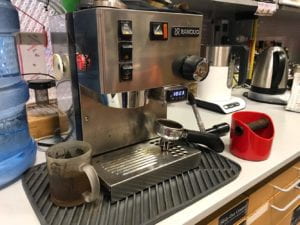At 7:00 AM on a Sunday morning, my all-too awake and cheerful teammates greet me as I step into the NTSI lab.
“Good morning, Will!”
“Mph.”
My bags hit the ground, and my feet carry me out. Water fills up a gooseneck kettle and starts to heat up. With an obnoxious whir the coffee grinder turns beans into a not-so-fine powder. A filter opens itself and falls into a decanter. The grinder turns off. The water, now boiling, pours over the filter and then back into the kettle. Coffee grounds fall into the filter. A small amount of water wets the grounds. A larger amount of water pours into and on top of the grounds. The coffee drips and drips . . . and drips . . . and drips. Five agonizing years later, the coffee pours into my mug. I take a sip.
“GOOD MORNING Y’ALL!”
I am a proud coffee heretic. I grew up drinking pour over coffee, and to the chagrin of every European friend I’ve ever made, I will die drinking pour over coffee. However, I have come to appreciate what they call making a coffee, where you press some buttons on a machine attached to some water and it gives you a concentrated shot of hot, brown, and bitter deliciousness. The Engineering and Design Studio, like many work spaces on the NYUAD campus, has one of these magical devices (see photo). After over a year of doing nearly all my class work and side projects in this space, I know what one button on the entire machine does, the one that provides coffee at 2:00 AM. To help eliminate my own ignorance, I observed several people making coffee using the machine when I was working in the space over the last few days.

Rancilio Silvia coffee machine in the EDS.
The most common frustrations with the machine revolved around the confusing interface. The buttons are either unmarked or marked with unfamiliar icons, intimidating users who lack prior knowledge. However, each person I observed used the machine with ease. It turns out that once users understand the functions of each feature, the layout of these features makes intuitive sense. When asked how they learned to use the machine in the first place, each person told me that they learned it from someone in the space, showing them the process and enjoying coffee with them after it was done. In a stressful work environment prone to isolating people with individual tasks, this small barrier to interaction drives users to share knowledge and enjoy a much-needed moment to breathe. What first struck me as poor interaction design turned out to be a driver of positive social interaction. For this reason, I am not going to tell you how to use the machine; you will just have to ask someone. As for the features I still did not understand, they are used to steam milk. As a member of the majority human group who cannot digest milk in adulthood, I will not be using these buttons. However, all is not lost; I can now make coffee with milk for a friend.
